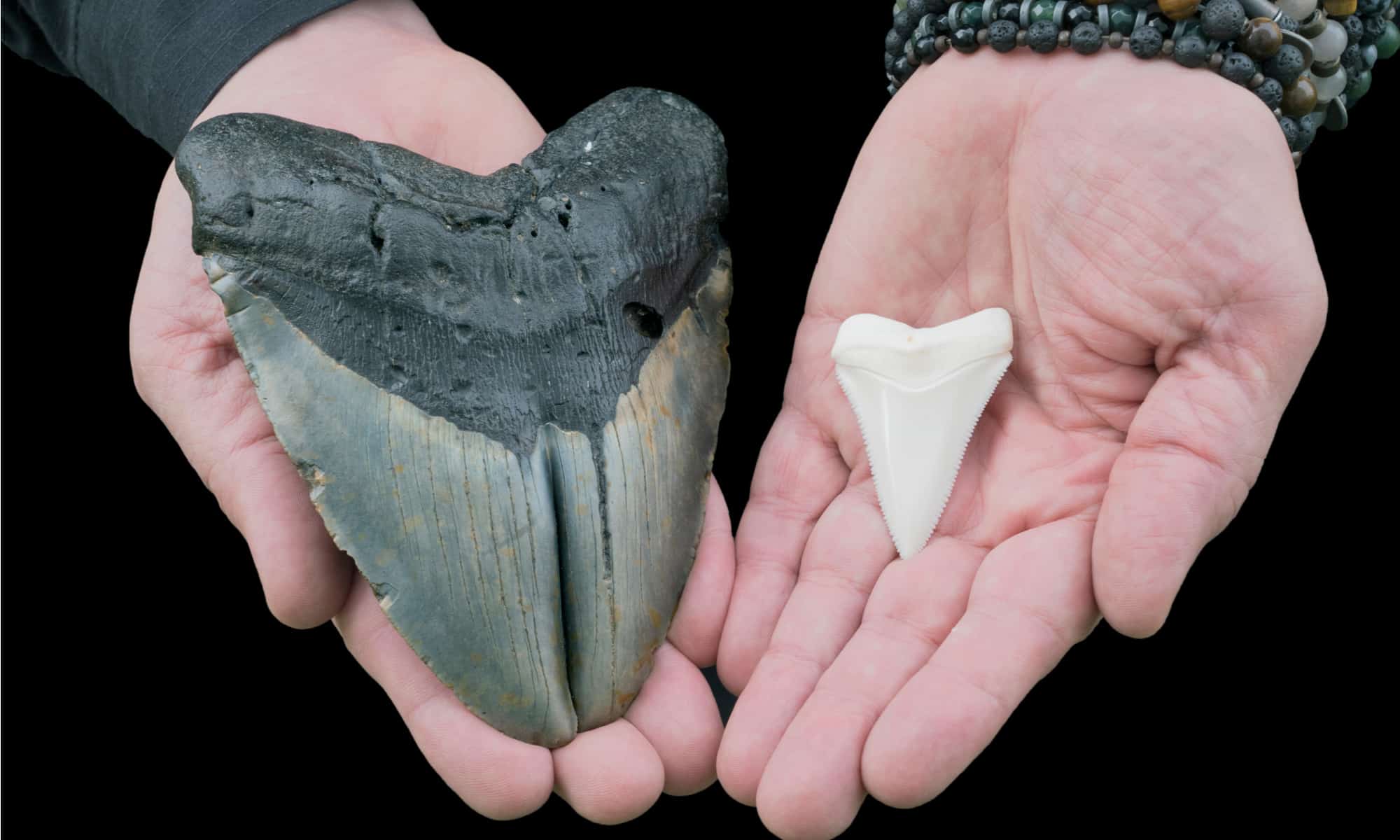
Dive into the fascinating world of sharks with the biggest teeth! With their sharp and serrated teeth, they effortlessly slice through prey, showcasing their exceptional hunting skills. But it doesn’t stop there – some ancient shark species boast teeth as large as a human hand.
Join us on this exciting adventure as we discover how these remarkable creatures use their massive teeth to become apex predators of the underwater world.
1. Megalodon – 7.48 Inches
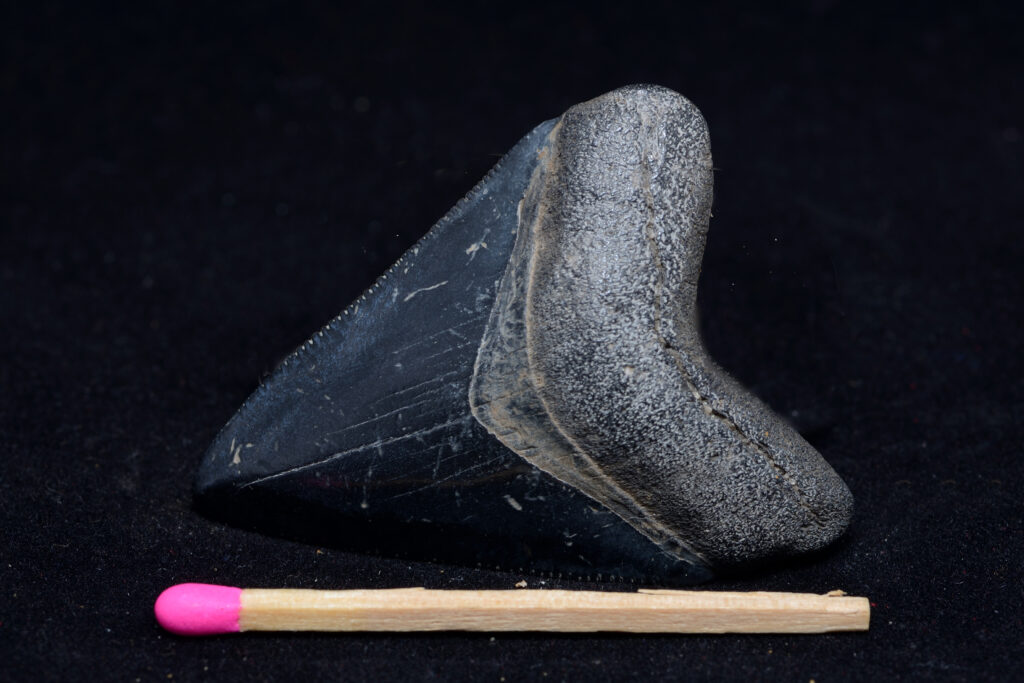
With an unbelievable tooth size of over 7 inches, the Megalodon was by far the largest shark ever!
©Lakeview Images/Shutterstock.com
The Megalodon is a prehistoric shark that was the largest shark to ever live. This beast was truly frightening and awe-inspiring, weighing more than 30 large great white sharks combined! Megalodons went extinct about 2.6 million years ago, so you can relax knowing you won’t come across one today on a casual swim in the ocean!
Compared to its modern relative, the great white shark, the megalodon had a shorter and flatter nose, along with a distinctively squashed jaw. These unique features set it apart from the sharks we see today.
Megalodon inhabited most parts of the ocean, excluding polar regions. Juvenile megalodons tended to stay near the shores, while adults preferred coastal areas but could venture into open waters. With its massive serrated teeth, the megalodon was a formidable predator, feeding on whales, large fish, and possibly even other sharks.
Fully grown megalodons averaged around 33.5 feet in length, with the largest individuals measuring an astonishing 58.7 feet! In fact, scientists believe it could have weighed as much as 60 tons! That’s nearly three times longer than the largest recorded great white shark and more than 20 times heavier!
The largest discovered megalodon teeth measure over 7 inches in length. These impressive teeth provide valuable clues about the size of the megalodon, indicating lengths between 45 and 60 feet.
Because the Megalodon went extinct so long ago, our understanding of the monster remains incomplete. The main fossil discoveries have been teeth and vertebrae, as most of the megalodon’s skeleton was made of cartilage, which doesn’t preserve well in the fossil record. There is still much more to uncover about this massive, mysterious sea creature.
2. Great White Shark – 3 Inches
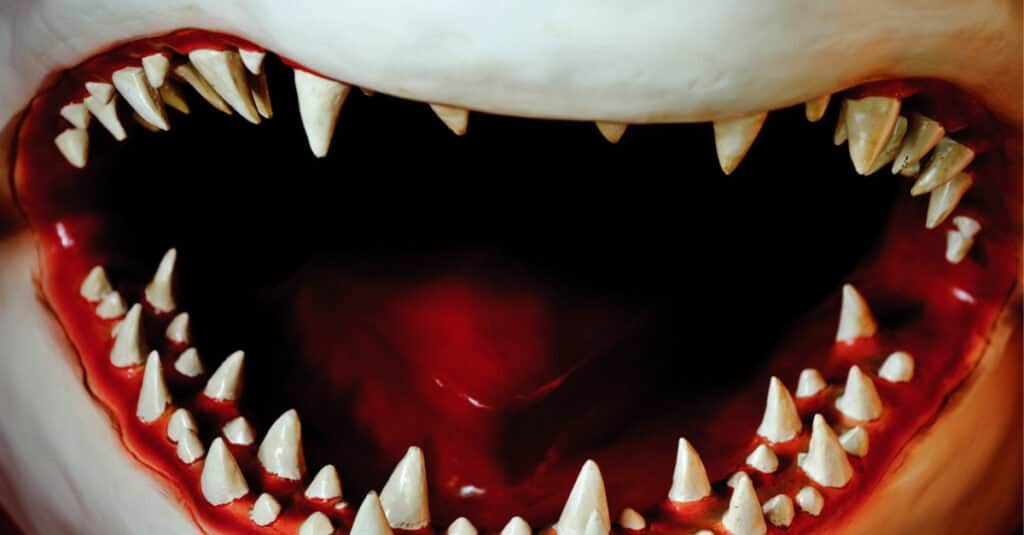
While not as impressive as a Megalodon, the great white shark still has insanely large teeth, measuring up to 3 inches!
©iStock.com/freie-kreation
The largest extant predatory fish in the world, the great white shark, is one of its kind. It is the most dangerous shark when it comes to human attacks (with 52 total recorded human fatalities). This remarkable creature gets its name from its white belly, while its upper body is dark gray to brown. Just like other “mackerel sharks,” the great white shark has a sleek, torpedo-shaped body with a pointed snout and a noticeable ridge at the base of its curved tail.
You can find these sharks in both near-shore coastal waters and out in the open ocean. As they grow, their preferred habitats change. Young great white sharks feed on different types of fish, including rays and other sharks. But as they mature, they develop a taste for marine mammals, especially seals and sea lions.
On average, great white sharks reach a length of around 15 feet. However, there have been incredible cases of individuals measuring over 20 feet long and weighing up to an astonishing 5,000 pounds.
The great white shark is a creature of legend, becoming the most feared sea creature after the movie “Jaws” depicted a massive shark wreaking havoc on a town in Martha’s Vineyard.
Now, let’s talk about their teeth! Great white sharks have teeth that resemble serrated blades. The upper jaw carries a row of 23-28 teeth, while the lower jaw holds 20-26 teeth. These triangular teeth can grow as tall as 3 inches. Surprisingly, despite 300 teeth, it doesn’t chew its food.
3. Mako Shark – 2 Inches
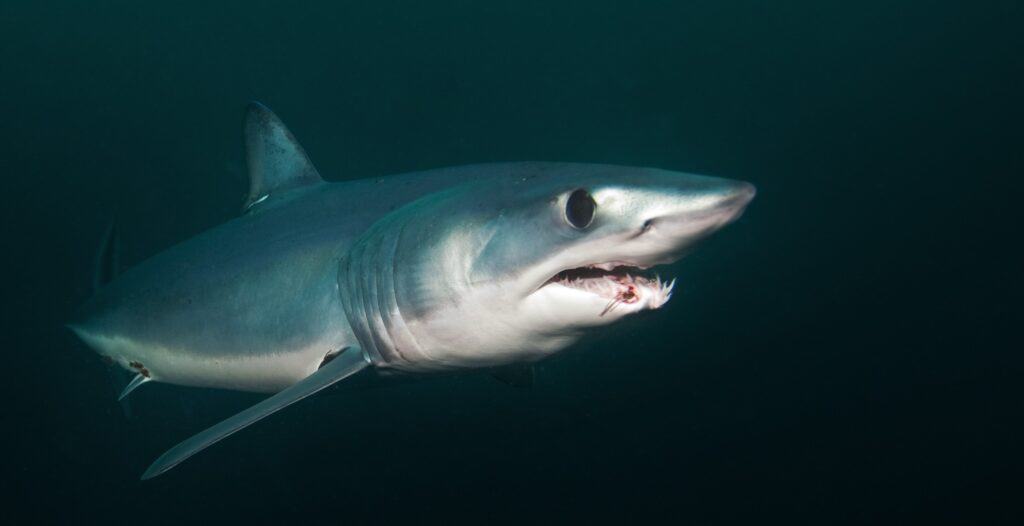
With an impressively pointed snout with very sharp and long teeth that protrude from their mouths, the mako shark is a terrifying predator.
©Martin Prochazkacz/Shutterstock.com
The mako shark is known for its aggressive hunting techniques and impressive speed! It is the fastest swimming shark, reaching speeds of up to 42 miles per hour in quick bursts.
These sharks have sleek and slender bodies with pointed snouts and curved tails. They come in different shades of blue-gray and deep blue on top, while their underside is white. The largest adult mako sharks can grow to be around 14.8 feet long and weigh over 1,100 pounds!
Mako sharks thrive in offshore habitats, living in tropical, temperate, or subtropical waters. They prefer to live in the open ocean, away from the coastline. They can be found from the water’s surface to about 500 feet below. What’s fascinating about Mako sharks is their ability to tolerate colder waters better than some other shark species. Despite the longfin mako’s preference for tropical water, the shortfin mako actually prefers cooler water. These sharks have been spotted as far from the equator as Scotland (in the northern hemisphere) or New Zealand (in the southern hemisphere)!
Mako sharks primarily feast on fish like herring, mackerel, and swordfish, as well as small marine mammals. They are highly valued as both a food source and a game fish, thanks to their strong fighting abilities and impressive leaps out of the water.
One special feature of mako shark teeth is their straight shape. Unlike teeth of other shark species with serrations, mako shark teeth have a straight cutting edge. This design makes them more efficient at slicing through their prey.
Additionally, mako shark teeth stand out due to their larger size when compared to teeth from other shark species. Some mako shark teeth can reach an impressive length of up to 2 inches!
4. Thresher Shark – 2 Inches

The most distinguishing feature of a thresher shark is its long, extended tails.
©Shane Gross/Shutterstock.com
Thresher sharks have remarkably long, curved tails that resemble a scythe. These tails are crucial in stunning their prey before they go in for the kill and feast.
In terms of appearance, thresher sharks exhibit a range of colors, including brown, gray, blue-gray, or blackish tones on their backs and undersides. Their sides are lighter, while their bellies are pure white. You can easily spot their blackish pectoral, pelvic, and dorsal fins, which sometimes have white dots on their tips.
These sharks thrive in temperate oceans all over the world. They mainly feed on small pelagic fish such as anchovies, sardines, hake, mackerel, and squid. However, surprisingly, thresher sharks also fall prey to larger predatory animals such as killer whales and bigger sharks.
Thresher sharks have a long lifespan, living up to 50 years, and they grow steadily throughout their lives. While most can reach up to 16 feet in length, the largest thresher shark ever found was nearly 20 feet! These terrifying beasts can also weigh in at around 1,100 pounds! One fisherman in the UK even claimed to have caught a thresher that was around 32 feet! However, this has yet to be officially confirmed.
Their teeth, although smaller than those of great white sharks, are notable for their small, blade-like shape with a smooth curved edge. Despite their different shape, thresher shark teeth can still reach an impressive length of 2 inches (although most are around 1.25- 1.5 inches)!
5. Tiger Shark – 2 Inches
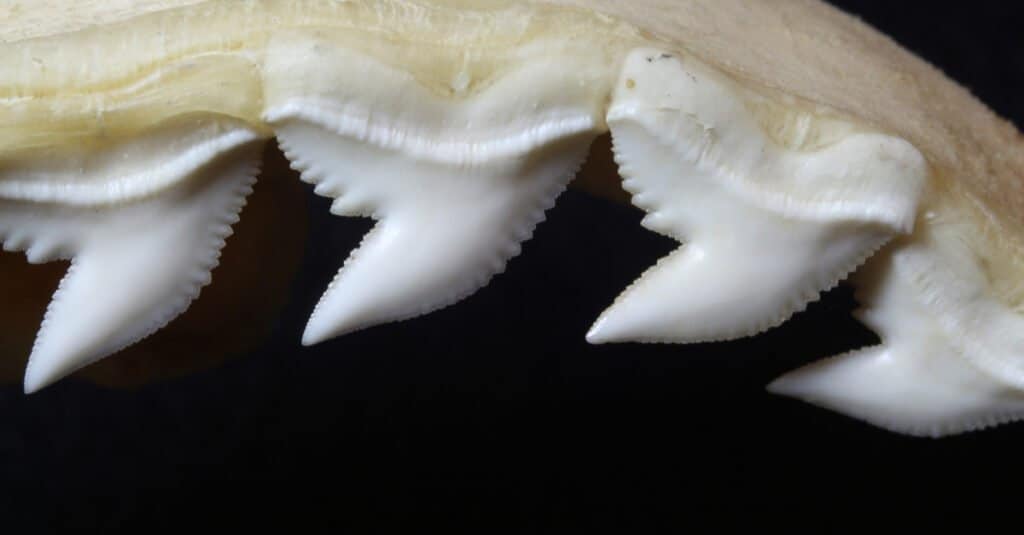
The teeth of
tiger
sharks have distinctive serrations and notches that are used to rip into their prey!
©Matthew R McClure/Shutterstock.com
Tiger sharks are considered one of the most dangerous and aggressive shark species. These notorious creatures are skilled scavengers equipped with exceptional sight and smell abilities, enabling them to locate a wide range of prey.
With a broad and flat head, the tiger shark boasts a snout that is shorter than the width of its mouth. Its slender body is complemented by long labial furrows, while its distinctive caudal fin is both long and pointed, featuring reinforcing ridges.
Tiger sharks are predominantly found in warm temperate and tropical waters, occupying both oceanic and shallow coastal regions. Their non-selective feeding habits and voracious nature have led them to consume a diverse array of marine creatures and, on occasion, even terrestrial animals.
As the water cools during winter, tiger sharks migrate to tropical regions in search of warmer temperatures to stay comfortable. And in the summer, they return to slightly cooler waters, ensuring they remain within their preferred habitat.
These sharks can reach massive sizes, measuring up to 12 to 18 feet in length and weighing over 1,500 pounds. Their blunt-nosed appearance contributes to their well-deserved reputation as man-eaters, ranking second only to great white sharks in their attacks on humans.
Usually, the teeth of a tiger shark measure about an inch in length. However, there are cases where they can grow up to 2 inches. What sets tiger shark teeth apart from those of other shark species is their short yet notched structure, making them easily identifiable and one of the key characteristics of a tiger shark.
6. Sand Tiger Shark – Over 1 Inch
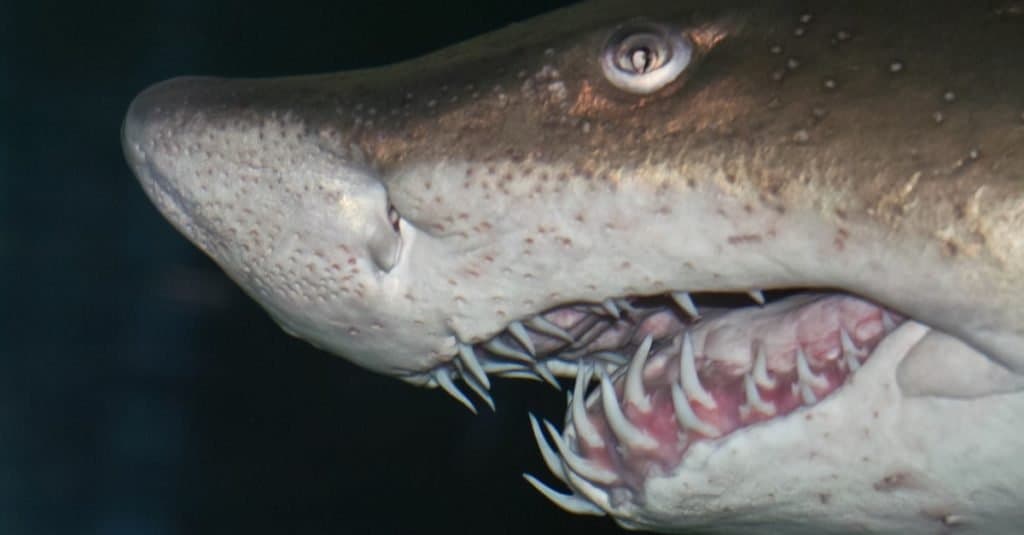
You definitely don’t want to encounter a sand tiger shark on a bad day. These teeth can do some serious damage!
©MP cz/Shutterstock.com
The sand tiger shark stands out as the only known shark capable of maintaining neutral buoyancy. They do this by ingesting air at the water’s surface and storing it in their stomach. This unique adaptation enables the sand tiger shark to effortlessly hover motionless in the water.
The sand tiger shark has two large dorsal fins. The first dorsal fin is positioned towards the posterior part of its body. Its elongated upper tail lobe lacks a caudal keel. The shark’s coloration is bronze on the upper side and progressively fades to a paler shade on the underside.
Frequently encountered in shallow bays, sandy coastal waters, estuaries, and tropical or rocky reefs, the sand tiger shark has a varied diet. It does not discriminate on the food it eats, feeding on both large and small bony fish, squid, rays, small sharks, and crustaceans. Thanks to its voracious appetite, its teeth are well-suited for capturing and consuming smaller prey.
The sand tiger shark is considered a medium-sized shark, as it can reach a maximum length of 10.5 feet and weigh up to 350 pounds.
When observed from the side, the sand tiger shark’s teeth exhibit an undulating curve from the root to the pointed crown. The teeth measure slightly over 1 inch in overall length. Another distinguishing feature of their teeth is the presence of tiny sharp protrusions, known as “cusplets,” extending from the root on either side of the pointed crown, making them easily identifiable.
7. Bull Shark – 1 Inch
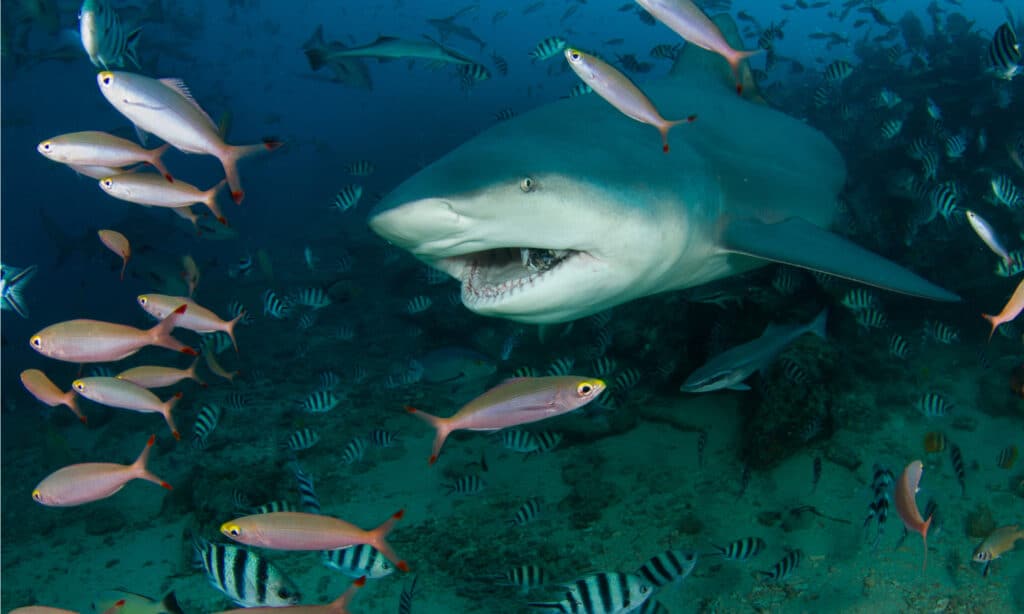
Bull shark among a school of fish in Fiji.
©chatchai kusolsinchai/Shutterstock.com
The bull shark stands out as one of the few species capable of surviving in freshwater environments. Its name is derived from its blunt snout, aggressive behavior, and tendency to ram into its prey before attacking.
Distinguishing itself from other sharks, the bull shark is very stout in appearance due to its high width-to-length ratio. Like many fish, it has countershading, with darker coloration on its upper side and lighter coloration on its underbelly.
The bull shark adapts to a wide range of habitats, spanning from coastal marine and estuarine areas to freshwater bodies. In fact, it is the only known shark species capable of prolonged stays in freshwater. Bull sharks are not picky eaters, enjoying a diverse menu that includes fish, other sharks, marine mammals, birds, turtles, and on rare occasions, even other bull sharks.
Male bull sharks typically reach a length of around 7 feet, while females can grow up to 11 feet or even larger. Adults generally weigh between 200 and 500 pounds.
While bull shark teeth may not reach the impressive lengths of other shark species, such as the megalodon, which can exceed 7 inches, they still possess fascinating qualities. Bull shark teeth are extremely sharp, thin, and capable of cutting through objects like paper. On average, the teeth of bull sharks grow to approximately 1 inch in length.
Summary of Sharks with the Absolute Biggest Teeth
| Rank | Shark | Teeth Size |
|---|---|---|
| 1 | Megalodon | 7.48 Inches |
| 2 | Great White Shark | 3 Inches |
| 3 | Mako Shark | 2 Inches |
| 4 | Thresher Shark | 2 Inches |
| 5 | Tiger Shark | 2 Inches |
| 6 | Sand Tiger Shark | 1 Inch |
| 7 | Bull Shark | 1 Inch |
Thank you for reading! Have some feedback for us? Contact the AZ Animals editorial team.

